Ladies and Gentlemen, we’re about to experience some turbulence. Please return to your seats and fasten your seat-belts. Flight attendants, please be seated.
After hearing this from the captain and after experiencing first jolt in the air, heart starts pounding, sweat starts rolling out, grip on armrest tightens, and body sinks into the seat. Level of anxiety completely depends on the severity of the turbulence. Hitting the rough patch in the air is not that bad for everyone. But understanding the roller coaster well, knowing when it happens, how it happens, advanced technology available till date to deal with it will surely calm the nerves down.
We posed our questions to varied experts of the airline industry. Here’s the article based on their answers with some more facts for better understanding.
What is Turbulence ?
When there is an unstable air movement caused by changes in wind speed and direction, such as thunderstorms, jet streams, and cold or warm weather fronts, flights flying-in the region experience turbulence. Moreover, it can occur when the sky appears placid. It can be invisible to both eye and weather radar.
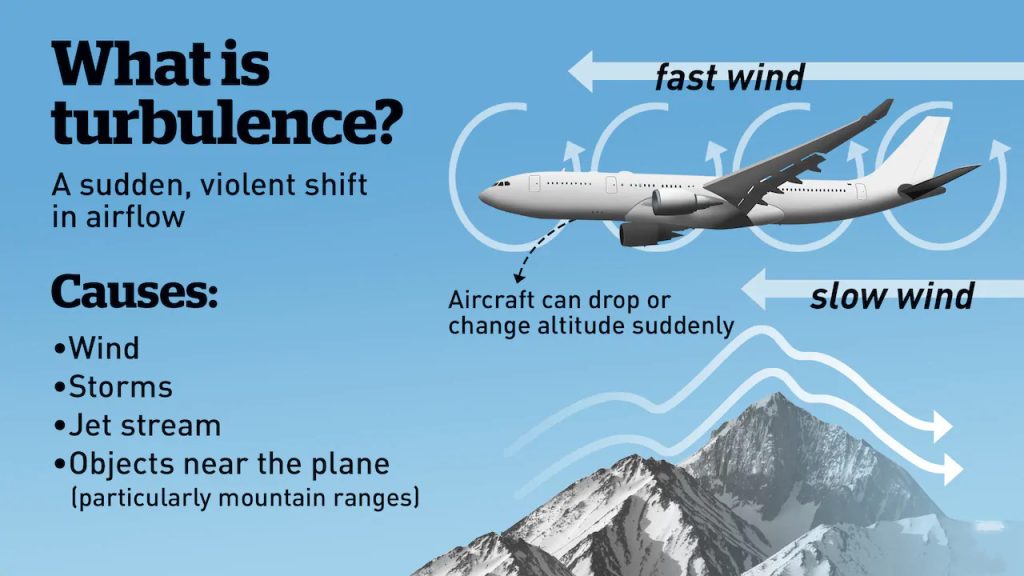
Turbulence Types
Turbulence in air can be classified into four categories- light, moderate, severe, and extreme. In extreme conditions, the pilot may lose control of the plane and there could be structural damage to the aircraft.
Recently Researchers
Researchers have recently made a noteworthy finding that storms have the ability to create uneven conditions in distant skies. According to Robert Sharman, a turbulence expert at the National Center for Atmospheric Research (NCAR), the swift expansion of storm clouds pushes air aside, leading to atmospheric waves that can transform into turbulence spanning hundreds or even thousands of miles away. It can cause Clear Air Turbulence, which is the reason behind severe to moderate flight turbulence.
Most incidents of severe air turbulence
Most incidents of severe air turbulence happen during storms or other severe weather events. Since the wind flow is not as smooth as an airplane wing, it rises and falls in the waves.
About 65,000 flights experience moderate flight turbulence every year in the US. On a Trans-Atlantic flight, passengers suffer 10-20 minutes of turbulence. And turbulence injuries cost US airlines at least $560 million each year.
Last year in December, more than 20 people including an infant were hurt, when an Hawaiian Airlines flight from Phoenix to Honolulu hit rough air. Two months back, Frankfurt-bound Lufthansa flight 469 was diverted to Dulles International Airport after they reported severe turbulence at 37,000 feet altitude over Tennessee. It left seven passengers injured.
These reports raise questions about the airline safety measures. With turbulence getting more frequent and intense, it is important to get prior information on turbulence forecasts in order to reschedule the flight or divert the route.
Most Common Activities That Result in Turbulence
Tom Bunn, a licensed therapist, retired airline captain, and founder of SOAR, has spent over 40 years developing advanced methods of controlling flight anxiety, claustrophobia, and panic. According to him, “Several situations can cause a rough ride. In Phoenix or Vegas, the sun heats up the desert, and that causes turbulence that is experienced during takeoff and landing. In Florida, there are usually afternoon thunderstorms. Pilots can fly around most of them when approaching the airport or when departing. But after lining up with the runway, it gets difficult for the pilot to turn left or right. So if there is a thunderstorm nearby, landing could be bumpy. One can also experience turbulence at cruise, if they are near the edge of the jet stream”
The most common sources of turbulence are jetstreams, thunderstorms (cumulonimbus clouds), mountain waves and other effects appearing at low altitudes such as thermals and microbursts. There could be several other reasons for turbulence as well. Turbulence is driven by temperature and velocity differences, so it follows the seasonal behavior of these. For example, winters tend to develop more turbulence than summers due to the stronger jet-stream activity, said Ignacio Gallego Marcos, founder of Turbli.com, who has expertise in turbulence modeling and Computational Fluid Dynamics.
It may be air in the atmosphere, jet streams that trigger changes in the wind flying above the mountains or ocean that change the wind flow in the sky. Basically, turbulence occurs mainly due to changes in the air.
Tom Bunn further added, “Clear air turbulence at cruise altitude is usually on the edge of the jetstream, where its fast-moving air scrubs against slow-moving air. Since the jet stream flows from west to east, some westbound or eastbound flights can avoid turbulence by staying north or staying south of the jetstream edge. But northbound or southbound flights are likely to cross the edge”.
However, most turbulence is not something to be concerned about. But sometimes severe weather conditions, especially in summer that are more prone to thunderstorms cause severe turbulence and can create panic among passengers. Even if the aircraft is approaching the runway, it may hover around the city for a while to avoid bumpy landing.
Is Turbulence Increasing?
Airlines are facing turbulence more frequently. Recent research has suggested that climate change is one of the main reasons behind rising numbers of turbulence in flights.
According to research conducted by Paul Williams, an atmospheric science professor at the University of Reading in England, there is a possibility of clear air turbulence tripling by the end of the century. This particular type of turbulence, which is most common at high altitudes and during winter, is observed to be increasing globally across all flight altitudes.
During flight cruising levels, light turbulence is present in approximately 3% of the atmosphere, while moderate turbulence occurs in around 1% of the atmosphere. Additionally, there is a small fraction, less than one percent, of severe turbulence in flight at any given time.
His research also indicates that there is a possibility of experiencing more turbulent flights in the future, leading to an increased risk of injuries for both passengers and crew.
The turbulence in mid-air also depends on the routes. British Airways captain Steve Allright in one of his interviews said that in his 10,000 hours of flying career, he rarely experienced turbulence, which was uncomfortable and not very dangerous.
How Often Turbulence Causes Injuries?
According to the Federal Aviation Administration, in the years between 2009 and 2021, a total of 146 passengers and crew were seriously injured due to the turbulence out of millions of passengers. So you can say airlines ensure safety and take all necessary measures to avoid such incidents.
The majority of passengers get injured during flight turbulence, weren’t either wearing seat-belts, or walking down the aisle, or due to luggage falling out of overhead bins.
Former FAA spokesperson Les Dorr in one of his interviews said that in most cases, crew members get injured during the turbulence as they are generally up and walking down the aisle, even when the seat-belt sign is on.
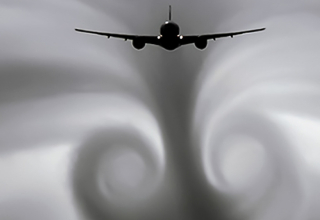
Sara Nelson, the president of the Association of Flight Attendants and a United flight attendant, shared her experience and said that some flight attendants have experienced being thrown against the ceiling multiple times, causing broken limbs. Additionally, there have been cases of passengers losing toes or being unable to walk due to unexpected turbulence in the aisle, resulting in long-term injuries preventing them from returning to their job for years.
Most Turbulent Routes and Airports
The unexpected bumps, shakes, and rumbles mid flight can be scary. While the occurrence of turbulence is unpredictable, it is best to identify the routes with the most turbulent history. Passengers of flights on both sides of the Atlantic experience the roughest rides. However, the turbulence over the Atlantic is seasonal. Jetstream intensifies in winters causing severe turbulence.
Turbulence is common in flights crossing over the Equator region due to strong upward currents and thunderstorm activity. In the latitudes of Europe, the United States, and Japan, turbulence is generated by the subtropical and polar jet streams. Out of these countries at similar latitudes, Japan experiences the highest level of turbulence. However, turbulence gets weaker over Canada, northern Russia, and Antarctica.
Turbulence at lower altitudes is predominantly influenced by mountain wave activity, particularly from the Rocky, Andes, and Himalayas.
Turbli has just released its most turbulent flights routes and airports. As per its rank Santiago (SCL) to Santa Cruz de la Sierra (VVI) ranks the highest turbulent route with average turbulence of 17.568 EDR. Santiago’s Arturo Merino Benítez International Airport (SCL) ranks the highest average turbulent airport with average turbulence of 34.921 EDR.
Listed below are the most turbulent flight routes in the world:
- New York – London
- Boston – Halifax
- Santiago – Santa Cruz
- Zurich – Millan
- Tokoname – Natori
- Sydney – Brisbane
- Trans-Atlantic Flights
- Trans-European Flights
- Cape Town – Durban
- Seoul – Dallas
- Flights near the Equator
- London – Johannesburg
- Flights to Reno, Nevada
- London – Glasgow
- Trans-Asiatic Flights
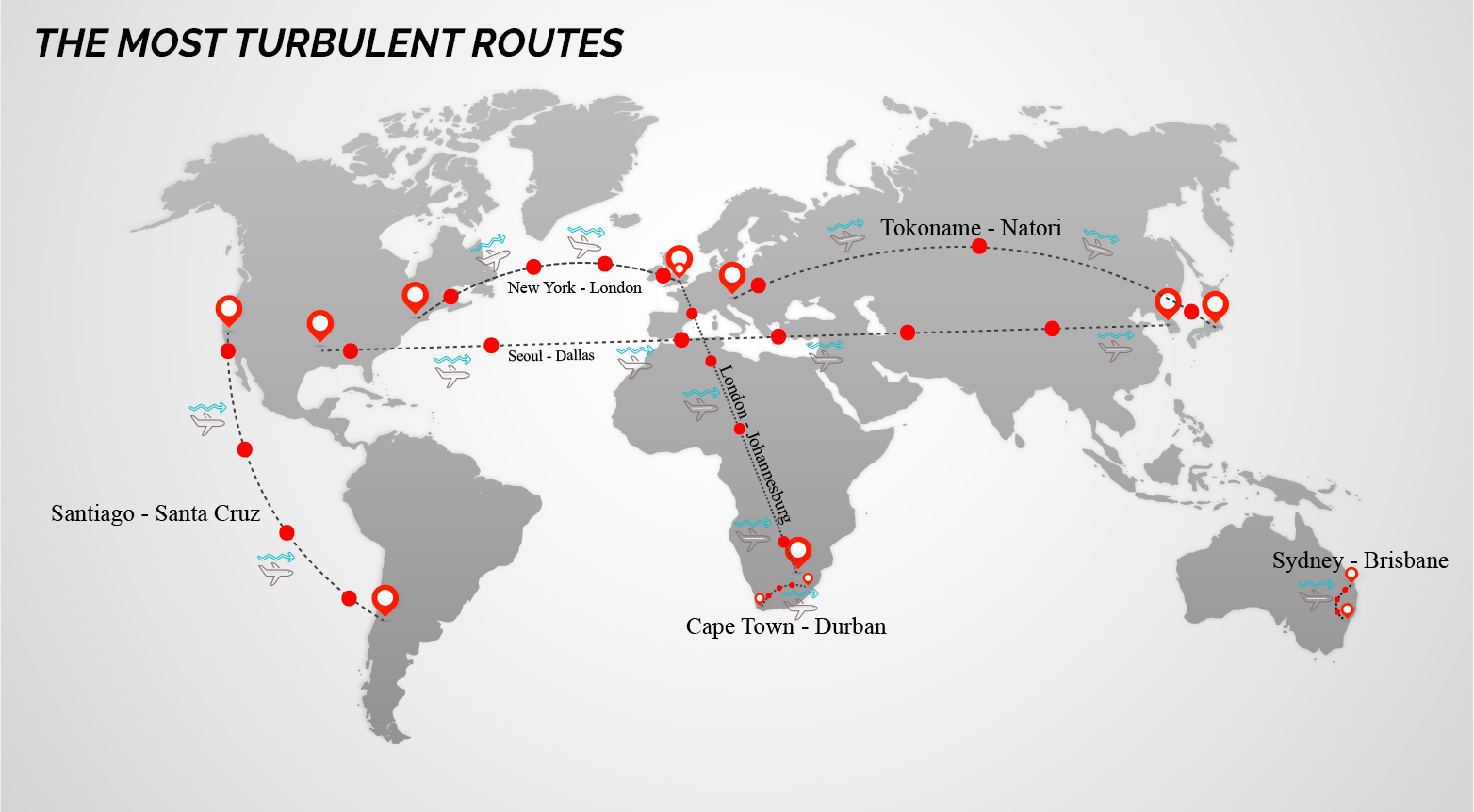
How is The Aviations Industry Working on Turbulence Forecast
Turbulence is undoubtedly a matter of concern when it comes to safety. Every year due to turbulence, a considerable number of individuals get hurt as they neglect to fasten their seatbelts. Cabin attendants are particularly vulnerable in this regard. At times, turbulence forces aircraft to divert its route, resulting in inconveniences and additional expenses.
Markus Ruediger, Assistant Director of Corporate Communications shed light on how IATA’s Turbulence Aware is helping pilots detect and avoid turbulence. To help airlines mitigate the impact of turbulence, IATA launched Turbulence Aware in 2018. By collecting anonymized turbulence data from thousands of flights by participating airlines, the platform creates a pool of information. This real-time and precise data allows pilots and dispatchers to select the most favorable flight route, avoiding turbulence and maximizing fuel efficiency to decrease CO2 emissions.
But how does it work?
He further added that IATA currently has a total of 21 airlines involved in the program, with more than 1900 aircraft providing data daily.
Markus Ruediger further added that Turbulence Aware is a global, industry-wide, data exchange platform that receives existing airline data from ground servers, performs quality control, de-identifies data, and provides the data back to airlines via a ground-to-ground, system-to-system connection.
Stay informed of turbulence with the Turbulence Aware viewer, accessible via wifi. It maps out real-time turbulence reports that will help you make better decisions for your operations.
Streamline the decision-making process by integrating with either in-house or third-party flight planning and in-flight weather tools.
EDR-based – EDR is a calculated parameter used to estimate the turbulent conditions of the atmosphere. The International Civil Aviation Organization (ICAO) and World Meteorological Organization (WMO) have designated EDR as the standard metric for measuring turbulence intensity.
Detailed report available for each data point – Including time, altitude, aircraft position, mean and peak EDR values as well as wind and temperature data, to increase situational awareness.
Anonymized data – To protect airlines’ identity and privacy.
Technical assistance – IATA provides assistance to airlines looking to implement open source EDR reporting software developed by the National Center of Atmospheric Research (NCAR).
Ignacio Gallego Marcos, founder of Turbli.com throws some light on how turbulence forecasts work. He said, “Turbulence forecasts are continuously being improved, but their resolution (13 km in the horizontal direction) is still too coarse to resolve clouds, so they cannot predict thunderstorm related turbulence. NOAA is actively working on a new forecast with cloud resolution, but it has not yet been released.”
Aircraft are equipped with weather radar that can detect the weather condition outside. The presence of abundant liquid water in storms can be identified using the weather radar system on board. When the aircraft approaches a turbulent area, it notifies the pilot, who further informs the passengers on board to fasten their seatbelts.
But according to Robert Sharman, a turbulence researcher at the National Center for Atmospheric Research, weather forecasts and pilots reports are only helpful to some extent. Weather models can’t predict turbulence at airplane-sized scales and chances of miscommunication cannot be denied.
So, how flight turbulence is monitored and measured? Meteorologists detect turbulence by using a range of algorithms, satellites, and radar systems to create comprehensive aviation forecasts, which include information on cold air, wind speed, thunderstorms, and turbulence. They indicate the specific locations and timings where potential turbulence may occur.
Pilots, with the help of Air Traffic Controllers (ATC) and turbulence forecasts, try to avoid turbulent areas by adjusting their altitude to find a smoother ride. This may involve flying above or below the predicted turbulence altitude, potentially leading to increased fuel consumption and additional costs.
But it is impossible to prevent and predict all turbulence. According to Tom Bunn, a former airline captain, “Prediction tools are not accurate. Prediction tools can only speculate about a region, where turbulence may occur. But that’s it. Turbulence comes and goes. The most accurate information is not prediction, but information pilots share either by talking with each other on the radio or by information collected by planes fitted with turbulence sensors that is sent to a computer on the ground which relays the information to other planes. This real-time information can be used to advise what altitudes on the planned route – at the moment – smoother or rougher.
Pilots can ask ATC about recent pilot reports. Even that information is too old to be useful. The only information that matters is what is being shared in real time, either by radio communication between pilots or by planes fitted with turbulence sensors via a ground-based server to pilots in the cockpit”.
So basically, the information you receive from ATC is just an anticipation. Therefore, pilots coordinate with other pilots flying or have flown in the area recently for the most recent updates on weather conditions.
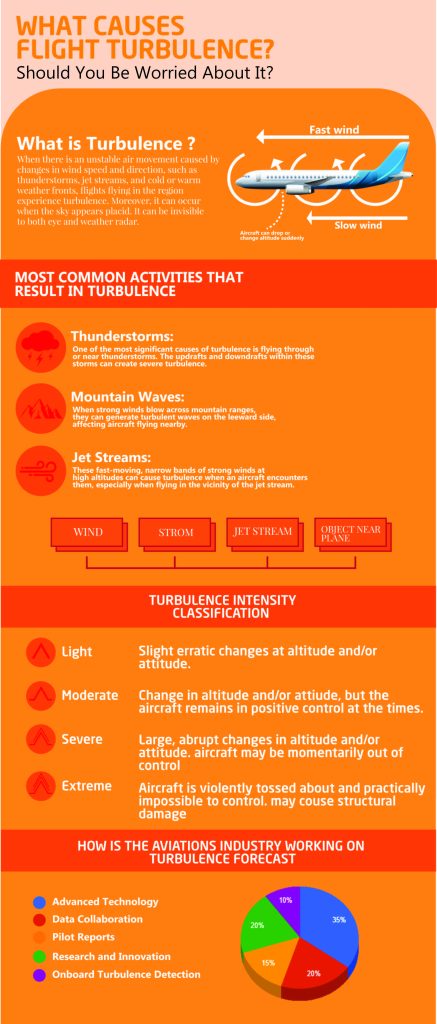
How Afraid Should You Be of Turbulence
Several air passengers have claimed that turbulence at the back of the aircraft is the worst. They can feel the jolts more strenuously than other passengers. They must remain buckled-up even when the seat-belt sign is off.
Most of the flight turbulence is not severe and is not something to be concerned about. Commercial airplanes are designed to endure extended periods of intense turbulence. Although the turbulence may cause discomfort during the flight, be reassured that the aircraft is not at risk of crashing.
Before the aircraft enters the turbulent zone, the pilot puts on the seat-belt sign and asks everyone to go to their seat. All you have to do is to follow the instructions. Turbulence is normal and has nothing to be worried about.

Additionally, in rarest of rare cases, if the weather outside is too extreme, then the pilots in the cockpit can reroute their aircraft to the nearest airport.
If you are still worried about turbulence or a little jolt in the aircraft scares you, then here is what you should do to avoid turbulence.
- Take an early morning flight, since the air in the morning is the smoothest.
- Fly with a larger jet as passengers on board a larger aircraft experiences fewer bumps.
- Avoid hurricane or monsoon season and travel either in spring or fall.
- Keep an eye on the weather forecast and the region you are traveling to.
IATA’s Turbulence Aware Initiative
The Turbulence Aware Initiative by IATA offers airlines up-to-date information on turbulence. According to Brenet King, the Head of Flight Operations at IATA, this program gathered and distributed more than 21 million flight in turbulence reports from 1,500 aircraft belonging to 12 different airlines in the year 2020. This platform fosters open collaboration within the global airline industry by enabling the sharing of real-time turbulence reports.
Delta, United Airlines, AirFrance, Southwest, Qatar, Lufthansa, and other two of a dozen airlines participated in a IATA Turbulence Aware program. All these airlines have access to the same turbulence data.
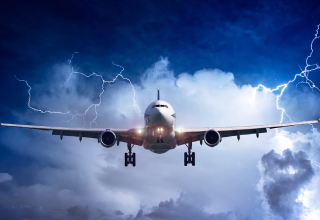
The only difference is the way they pass on the information to the pilots during the flight. These participating airlines are equipped with sensors that can measure how smooth or bumpy the ride would be. This data is further sent to the IATA Turbulence Aware platform. The IATA Turbulence Aware platform receives this data. With a continuous stream of data coming in from numerous aircraft, pilots are promptly alerted about existing weather conditions in real time. The data is also used to predict upcoming conditions.
Bottom Line
Each year, over 65,000 flights encounter turbulence, with only 5,500 of them experiencing moderate to severe turbulence in flight. Nevertheless, it is extremely rare for a plane to crash as a result of turbulence. It is not uncommon for passengers to sustain minor injuries due to not wearing seatbelts, walking in the aisle during turbulence, or bags falling from overhead bins.
While turbulence can be unsettling at the moment, there’s no reason to panic. Remember, flight attendants are always there to assist you if you suffer from any kind of anxiety.